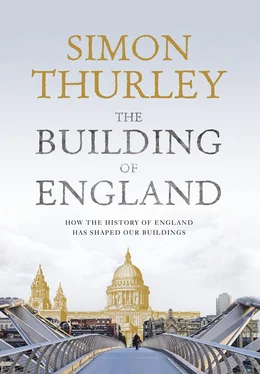The abbey church lay at the heart of monastic life, the focus of the Opus Dei (the work of God), the eight daily services and the celebration of Mass. Early Cistercian churches were divided into three ( fig. 64). The western part was reserved for the lay brothers, who were responsible for the heavy manual work of the abbey. They took simpler vows and attended fewer services. Then there was the retro-choir, divided from the lay brothers by a screen topped with a rood (crucifix); this was reserved for old and infirm monks unable to withstand punishing attendance in the choir day and night. At the east end and under the crossing was the monks’ choir, the hub of the church. The presbytery was in a stubby east end flanked by altars. This arrangement served Rievaulx well for a century, but between 1220 and 1250 a huge new east end was built in the Gothic style. Cistercian churches began extending their east ends from the 1180s and, as we have seen, this was happening in many cathedrals too (p. 96). The work was done with great richness and expense, and reflected the incredibly successful exploitation of the abbey’s estates by successive abbots. As at many cathedrals, Rievaulx’s new east end was built to contain a shrine for their very own saint, Aered ( fig. 65). This shrine, which was covered in silver and gold, explains the magnificence of the new architectural work that otherwise might have seemed too lavish for an order devoted to simplicity. The new east end cannot only be explained as an expression of architectural hierarchy, for by the 1220s other factors were involved. There were now few, if any, lay brothers, and so the nave was sealed from the choir by a huge stone pulpitum (screen) and used mainly for processions. Second, despite resisting it at first, the Cistercians were now prepared to offer Masses for the souls of donors (votive Masses), and this meant that more private chapels were required. As about one in three monks was ordained, there were probably 35 priests able to celebrate Mass, for whom five chapels against the east wall would have been a welcome addition. 12
Where the Rich and Powerful Lived
Up to the 17th century kings and their households were constantly on the move. Organising the royal itinerary was a precise task as monarchs spent particular times of the year in specific places, above all during the great religious feasts of Christmas, Easter and Whitsun. They would also want to appear at provincial residences to reinforce their judicial, administrative and military policies and, crucially, to hunt in the royal forests. Royal houses and castles formed the points around which the court gyrated ( fig. 66). The king’s preference dictated where they went, what was repaired, built or extended, and when. In each county the sheriff was responsible for organising royal construction work. However, just as bishops and deans employed architects to oversee big projects, so the king had ingeniatores (engineers or designers) in his household. The first of these about whom we know anything was an Englishman called Ailnoth in the 1150s; under him were the master craftsmen, the masons, carpenters and others – all highly paid technical experts, not just workmen. Ailnoth was responsible for Westminster, the most important royal house in England up until 1512, although the precise layout of the palace is unclear before the reign of Henry III (p. 144). The provincial civil residences of the Crown fell into two groups: those large manors that we can legitimately call palaces, such as Clarendon, Wiltshire, and Woodstock, Oxfordshire; and smaller houses situated in royal forests that were used as hunting lodges, such as Writtle, Essex, and Kinver, Staffordshire. Clarendon was the largest and most important royal house in the west. It was excavated in the 1930s, and it is possible to walk through the fields and see substantial chunks of masonry still standing in front of spectacular views of Salisbury.
|
| Fig. 66 Royal castles and houses in the reign of King Henry III (1216–72). |
|
| Fig. 67 Clarendon Palace, Wiltshire; a reconstruction as it might have appeared in about 1275 looking north-east: a) great hall; b) kitchens; c) King’s chambers; d) Queen’s chambers; e) gatehouse; f) stables. |
| Clarendon was a complex of one- and two-storey buildings whose pitched and tiled roofs were arranged in a long line running approximately east–west. At its heart was Henry II’s aisled great hall, with kitchens and larders to its west and the royal chambers to its east. The various parts of the building were arranged around cloisters containing gardens; these and other pentices linked the various parts. The house was largely built of stone, and contained rich carving and particularly spectacular tiled pavements, now in the British Museum. 13The king’s hunting lodges were similarly laid out; the one at Writtle, Essex, excavated between 1955 and 1957, was surrounded by a moat. Approached by a bridge and gatehouse, the buildings were again laid out in an axis, with a hall, a kitchen and a chamber ( fig. 67). A house such as Writtle was not small; its great hall was about the same size as Clarendon’s, but the accommodation was less extensive and built of timber, wattle and daub, not of stone. 14 |
| These houses, great and small, were not materially different in layout from their Saxon predecessors such as Yeavering or Goltho (pp 29 and 55). They were axially planned, with a large ground-floor hall and a more private chamber slightly detached from it. This continuity of plan suggests a continuity of function, with the royal households living much like their predecessors. At the heart of this was still the hall, a structure of fundamental importance to anyone of any means and pretension, not only to royalty. The hall was no mere structure; it signified its owner’s social standing and was the centre of his public life. An example, although not a royal one, survives at Oakham, Rutland ( fig. 68). It was built in around 1190 as part of a castle belonging to Walkelin de Ferrers, a sub-tenant of the Earl of Warwick. De Ferrers or his architect must have had close connections with Canterbury Cathedral, as the wonderfully crisp and lively carving of corbels and capitals is closely related to contemporary work there. The room is of four bays with low aisles. The entrance door has been moved and originally would have been at the east end, with a dais for the owner at the west. With a fire in the middle of the floor, long tables and heavy drinking, the scene on a feast day can hardly have been much different from the time of Beowulf. |
Fig. 68 Oakham Castle, Rutland; a very rare survival of a great hall of around 1190. It is built like a church with a central ‘nave’ and aisles, though without clerestory windows. The door was originally in the far right bay and the dormer windows are later additions.
Fig. 69 Dover Castle, Kent. Henry II’s Great Tower dominates the castle and is surrounded by a mighty curtain wall with 14 towers and two gates, one of which can be seen in this view. In the foreground are the 13th-century Norfolk Towers and the circular St John’s Tower, while in the background can be seen St Mary in Castro ( fig. 34).
While the disrupted reign of King Stephen saw less permanent castle construction, in the reigns of Henry II, Richard I and John this was the largest single item of royal expenditure, consuming ten per cent of royal income. There was serious purpose behind this. First, it was necessary to modernise the forts of the south coast as a protection against invasion, but also as a springboard for continental expeditions and to protect communication routes to the continent. Then it was necessary to protect England’s internal borders against the Scots and the Welsh. Perhaps most important of all was the lavishing of money on strategic royal castles inland. These had been established as the administrative, judicial and financial nodes of the kingdom, and many had become favoured royal residences too. All performed another crucial task, of emphasising royal lordship over both great and humble.
Читать дальше












